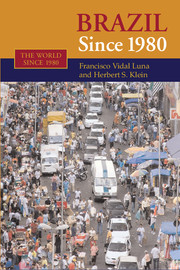Book contents
5 - Industry and Mining
Published online by Cambridge University Press: 03 June 2010
Summary
Industry and mining were among the sectors most influenced by the opening of the Brazilian economy that occurred after 1990. The dismantling of tariff protection had begun with the Collor regime and was further extended during the government of Fernando Henrique Cardoso, and was accompanied by the privatization of the majority of state industrial enterprises, including that of one of the greatest mining companies in the world. This combination of policies occurred in a very short period of time. It profoundly affected the industrial sector and provoked an intense modernization and denationalization of a very significant part of the industrial base, which became integrated into the productive processes of the great multinational corporations. Productivity undoubtedly grew, but at the cost of industrial employment. The export of industrial products expanded, but so did the ratio of imported goods used in the manufacturing sector. The size and sophistication of the industrial base allowed it to survive the dual shock of open competition and privatization, in contrast to the industrial decline that occurred in several Latin American countries.
Antecedents
The beginnings of Brazilian industrialization can be found in the second quarter of the twentieth century. Essentially an agrarian economy until the crisis of the 1930s, the country entered the world market as a primary coffee producer. The dominant economic liberalism of the period fortified the raw materials exporters, and the central power of the state was controlled by groups related to the coffee economy and international commerce.
- Type
- Chapter
- Information
- Brazil since 1980 , pp. 136 - 157Publisher: Cambridge University PressPrint publication year: 2006



